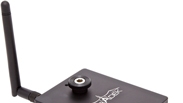IP to be future of newsgathering backhaul

Finding a cost-effective solution for the backhaul of news feeds from the field has always been a challenge for news stations.
Traditionally, news organizations have relied on expensive satellite- or microwave-equipped ENG vans. More recently, broadcast backpacks that aggregate the video stream over multiple cellular data networks have become a popular alternative.
With the release of Teradek’s Cube video encoder, news organizations have an elegant solution to stream HD video to the station over a single IP network connection. Cube is a camera-top, H.264 HD video encoder that mounts easily to any camera using a 1/4-20 screw or hotshoe mount. It can stream HD video up to 1080p30 over IP.
The unit is about the size of a deck of cards, so it doesn’t impede in the mobility of even the smallest camera rigs. The Cube, which uses only 3.5W of 9V-24V DC, features both wired Ethernet outputs and WiFi. Buyers can choose between HD-SDI or HDMI inputs.
The encoder uses H.264 High Profile (Level 4.1) video compression and features a built-in scaler to convert from 1080 to 720 or 480 resolutions. Users can choose a resolution and target bit rate based on the availability of IP bandwidth. Typical bit rates for HD are between 2Mb/s and 4Mb/s; SD bit rates are typically less than 1Mb/s.
Getting video onto and retrieving it from the public Internet presents challenges, but Cube simplifies the process. The unit features RTP push to easily broadcast from behind firewalls, and on the receiving end, the station has several choices. One option is to host a computer with a public IP address, which most stations likely already have installed, and direct the video stream to it. Another is to use Cube’s native Livestream integration. Users with a Livestream account can simply log on to the unit’s Web user interface and enter a user name and password to begin broadcasting via their Livestream channel. Livestream users can choose between public webcasting or making the channel private so news from crews in the field can stream privately and discreetly back to the station for broadcast distribution.
The wide implementation of 4G cellular data networks in 2011 means that journalists can use a Sprint Overdrive, Clear Spot or similar 4G WiFi hotspot to bring along their own broadband WiFi access point. Where an entire ENG van only year ago was reduced to a backpack, it now is reduced again to the size of two decks of cards. Data rates with this approach are high enough to provide Blu-ray-quality video over a single IP data connection.
Get the TV Tech Newsletter
The professional video industry's #1 source for news, trends and product and tech information. Sign up below.
The increase in mobility as compared to a traditional ENG van means that, for the cost of a lift ticket, newscasters can report live from the summit of the local ski resort rather than the parking lot. Sportscasters have successfully tested a direct-to-Livestream connection from a large radio-controlled helicopter and are planning to use Cube to broadcast aerial footage of professional surfing and automobile races when the 2011 season begins.
News organizations employing IP video solutions have a competitive advantage in the market, with greater mobility, lower cost and the ability to put significantly more feet on the street on the same budget or even for a profit. With pervasive WiFi coverage and 4G availability, IP is the future of backhaul.
